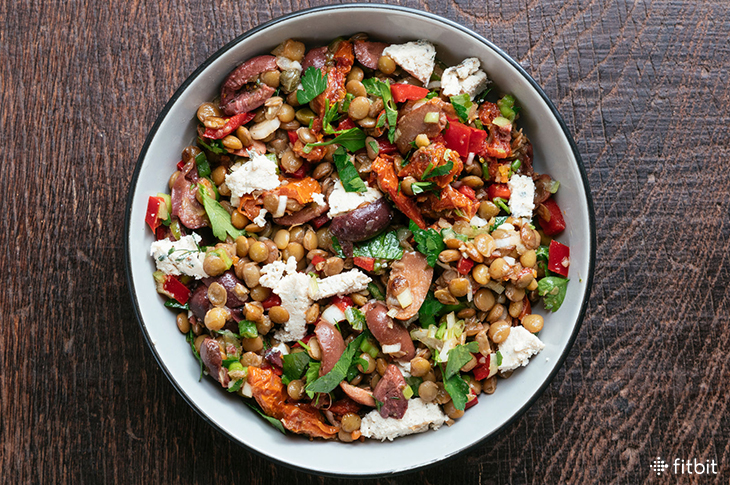
You probably think of meat, poultry, eggs, and Greek yogurt when you hear “protein.” But plants also provide the muscle-building macronutrient—with added benefits. “Plant protein is kind of a three-for-one,” says Joan Salge Blake, Ed.D., R.D.N., author of Nutrition & You and a clinical associate professor at Boston University. “Not only is it low in saturated fat, which can increase your risk of heart disease, it also provides blood cholesterol–lowering soluble fiber. And it’s much cheaper per pound than animal protein.”
To help you put more plant-based foods onto your plate without sacrificing gains, here’s a half dozen of the most protein-packed options.
PLANT FOOD: Lentils
PROTEIN: 18 grams per 1 cup
PREP: Though all lentils are quick-cooking, the red ones are the speediest. They shine in soups because they fall apart, so you get a purée-like consistency without having to dirty a blender. Black (or beluga), green (a.k.a. French or Puy), and brown lentils, meanwhile, tend to hold their shape. Warm and cold salads are no-brainers, but you can also use lentils to make vegetarian meatballs, bolognese, and burgers.
PLANT FOOD: Edamame
PROTEIN: 18 grams per 1 cup
PREP: Though tofu and tempeh, which are made from fermented soybeans, have more protein per serving, edamame are the least processed form of soybeans you can buy. And they’re dead-simple to prepare: just boil or steam them in their pods or buy the shelled kind (you’ll find both in the frozen-food aisle); stir into a black-rice salad; toss with whole-grain pasta, olive oil, garlic, parsley, and Parmesan; or whir in a food processor with olive oil and lemon juice to make a dairy-free dip.
PLANT FOOD: Pumpkin seeds
PROTEIN: 9 grams per ounce
PREP: Also called pepitas, pumpkin seeds are available either raw or roasted and (usually) salted. Mix the former into homemade granola, sprinkle them over whole-grain apple or pumpkin muffins before baking, or sub them for pine nuts in pesto. Roasted pumpkin seeds, which are much crunchier, make a great snack or salad topping.
PLANT FOOD: Pinto beans
PROTEIN: 16 grams per 1 cup
PREP: A medium-size variety of kidney bean that’s used to make refried beans, pintos come canned and dried (you’ll just need to rinse them, soak them overnight, then simmer them for about two hours with some aromatics, such as onion and bay leaf, or cook them in a pressure cooker). Either way, they work well in chili, vegetable stews, and tacos.
PLANT FOOD: Spinach
PROTEIN: 5 grams per 1 cup, cooked
PREP: You’d have to eat heaps of raw spinach to make a dent in your protein needs. Luckily, this leafy green cooks down considerably. Sautéed with a little garlic and olive oil, spinach can stand alone as a side dish, or as an add-in to a brown rice bowl or pasta dish. The baby kind requires very little prep, as does frozen spinach, which comes blanched, chopped, and ready for use in lasagna, dips, and even smoothies.
PLANT FOOD: Kamut
PROTEIN: 10 grams per 1 cup cooked
PREP: Kamut is a kind of large-kernel, ancient wheat, meaning it’s been relatively unchanged by farmers since people first started eating it. Sometimes sold as “kamut berries” or “Khorasan wheat,” kamut can often stand in for wheat berries or farro. Try it in a grain bowl; with cucumbers, tomato, and feta in a salad; or simmered with a little maple syrup and served with a splash of milk and fruit for breakfast.
This information is for educational purposes only and is not intended as a substitute for medical diagnosis or treatment. You should not use this information to diagnose or treat a health problem or condition. Always check with your doctor before changing your diet, altering your sleep habits, taking supplements, or starting a new fitness routine.

Studies have shown saturated fat and cholesterol are not the cause of heart disease. It should also be noted that just because certain vegetables have higher protein content does not mean that protein is bio-available, that is, your body can’t process it the way it processes animal protein.
That view is not supported by many studies in Western Europe.
Read the work of Dr. Caldwell Esselstyn and the China Study, fat and cholesterol most definitely cause heart disease. A plant based diet is recommended to reverse high cholesterol and to prevent heart disease, unfortunately most Americans are not willing to make those kinds of dietary choices.
I have read that high cholesterol is often an individuals body type and really has nothing to do with what a person eats. For every statement that says it does cause heart disease there is a statement that says quite the opposite. I think the medical and scientific community needs to get together on this, because as far as I can see there are too many contradictions.
I AGREE! I eat mostly plant based, 62 yrs old, fit and am 5’4″, 107 lbs yet my cholesterol is high..so was my mom’s..go figure!
Your absolutely right!!!
As I know one more food have same amount of 100 gr meat is tofu (which made from soya). And body can process it like animal protein.
I do not tolerate soy well, very small amount is ok but no way I can eat tofu. Fortunately I love beans and nuts so not a problem to go meatless. 🙂
As I know one more food have same amount of 100 gr meat is tofu (which made from soya). And body can process it like animal protein.
A couple of anchovy fillets make sautéed spinach even better, with oil and garlic (maybe even a touch of chilli)
Very interesting, but could you help us Brits. How much does a cup weigh? Grams or ounces. Thanks
A cup is a volume measurement, not weight. A cup, in America, is 8 fluid ounces. Hope that helps!
A cup is a volume not a weight, so a cup of spinach would weigh considerably less than a cup of beans.
1 cup is 250ml or 8 oz
Not plant based then is it!
I noticed the grams of protein were listed, how about the carbs?
Photograph of the item would have been more useful to easily know the local item in a different countries.
Would “Kamut” be ‘legal’ on the Paleo diet since you say it is a type of wheat?
I found the the info on protein rich plants interesting. I am a vegetarian, and have low iron. I unfortunately have a medical illness, taking steroids doesn’t help. So I am always looking out for more veggie info. Thank you.
How about a recipe for what is pictured on this page??!!
I too would like a recipe. Thank you. It looks delicious.
What is the easiest way to shell pumpkin seeds that I grow? Should I roast them before or after they are shelled?
Most plant sources of protein are incomplete. Pinto beans are not a complete protein, Neither are lentils. You have to eat rice with them to complete the protien. .
You are giving out bad advice.
No such thing as incomplete protein, that is old research that has been debunked.
Most plant sources of protein are incomplete. Pinto beans are not a complete protein, Neither are lentils. You have to eat rice with them to complete the protien. .
You are giving out incomplete advice.
I too would like a recipe. Thank you. It looks delicious. I can see it has
kalamata olives
sundried tomatoes
lentils
slivered almonds
chopped red peppers
feta
cilantro
bacon (JK) 🙂
Thank you for this information. It confirms that my favorite salad has some of the above recommended ingredients. It is an edamame, black bean, wheat heart salad. I got this recipe from a wonderful program to reverse a pre-diabetic condition. This salad I keep made up in my fridge most the time.
Such dietary decisions are not only good for overall health, energy, and fitness, they are economically available to all.
I eat four simple meals per day (groats for breakfast, mostly beans & rice for the other three – with fresh vegetables) and I spend less than $2/day.
Besides a high energy level for my active lifestyle, controlling portion size has resulted in a loss of 35 pounds in the past year.
Simplicity is wealth!
I appreciate this post….because I am a vegan! We don’t need animal products to get enough protein!
Hello,
Living a lifestyle of eating 3 times a day meat, veggies, and desert….I stayed
slim and found as I got older I did not like eating 3 meals a day….like the
“Leave It to Beaver” household that I grew up in such surroundings. Over the
last few years, I am trying to figure out what my body likes and agrees with it.
Food tests says the Mediterranean diet is best for me and that wheat and lactose are not good for me. Honestly, I do not know or have enough knowledge yet. But I was happy to hear about the spinach, lentils, pinto beans and pumpkin seeds which seems very satisfying when I eat these items! Thank you for helping me learn.
“Not only is it low in saturated fat, which can increase your risk of heart disease, it also provides blood cholesterol–lowering soluble fiber.
Is this correct “increase your risk of heart disease”?
Shouldn’t the article say lower your risk of heart disease not increase your risk?
I think they mean “the saturated fat” increases your risk of heart disease.
I’m looking for protein recipes that type 1 diabetics can have. Any of those?
I really would like to know all ngredie to in dish photo on this page
Where are the recipes? It’s nice to show the pictures of the food and what they are good for but it would be nice to pose the recipes so we can try them. Am I missing something?